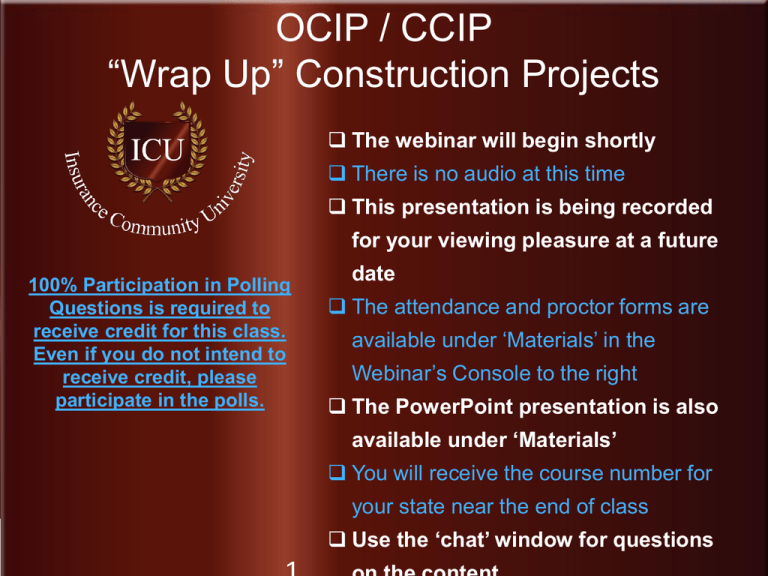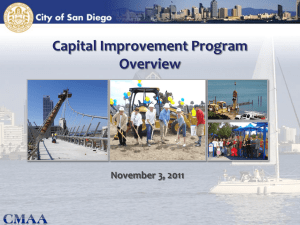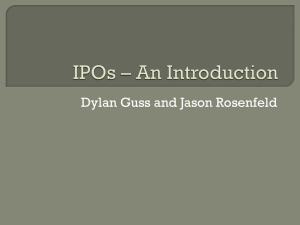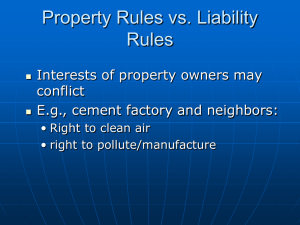
OCIP / CCIP
“Wrap Up” Construction Projects
The webinar will begin shortly
There is no audio at this time
This presentation is being recorded
for your viewing pleasure at a future
100% Participation in Polling
Questions is required to
receive credit for this class.
Even if you do not intend to
receive credit, please
participate in the polls.
date
The attendance and proctor forms are
available under ‘Materials’ in the
Webinar’s Console to the right
The PowerPoint presentation is also
available under ‘Materials’
You will receive the course number for
your state near the end of class
Use
the ‘chat’ window for questions
Insurance Community
University
Welcome to your Insurance
Community University
Audio
• All of you are currently on mute
– Un-mute your own system
– Telephone Option
• Select Telephone on your screen
• Dial in the PIN number so that your number
becomes active
– Microphone and/or Speaker Option
• You can use this option if you have a headset
Insurance Community
University
2
that you use
with your computer
Participation & Chat Window
• You will receive information from the monitor via
the ‘Chat’ window.
– Please locate window in the control panel
• Q & A is welcomed during the presentation and at
the end of the presentation
• You will find the question box on your control
panel
– Write your question in that box
and send it to the presenter/organizer
• The presenter will take those
• questions in the order submitted
Insurance Community University
3
DOI Requirements
• When you see a slide with the hand up symbol, touch
the “hand” icon on your control panel
– Click ONCE only
• If you do not raise your hand, the monitor will be in
contact with you in the chat box
• If you are in a group, the designated proctor is
responsible to make certain you are all in attendance
at all times
= Hand is down
Insurance Community University
4
Polling
• Throughout the class we will be
conducting periodic polls
• We need 100% participation on the polls
• The polls are intended to check
participation but also to create
discussion topics throughout the
presentation
Insurance Community University
5
Forms To Complete for CE
• After class ends
– Return attendance form
– Proctors – return your form to email
address
• Email address is in chat window or in
email sent to you today
Insurance Community University
6
DOI Requirements
• We will file your hours with the DOI
after the completion of this webinar and
we have received the attendance form.
• You have 48 hours to return the form
• You will be sent a Certificate of
Attendance/Completion by
email. Please retain this for your
records for five years.
Insurance Community University
7
Internet Disruption
• If the presenter looses internet
connection STAY ON THE LINE
• The administrators will communicate
with you
Insurance Community University
Internet Failure
• If the internet fails and all participants
are kicked off line by Go To Training or
other source then the seminar will be
terminated
• You will receive instructions by email as
to how we will proceed
• This is a precautionary notice, only
Insurance Community University
9
This class is being recorded
• Available in the University
• Does NOT qualify for CE
Insurance Community University
Disclaimer
Insurance forms and endorsements vary based on insurance
company; changes in edition dates; regulations; court decisions;
and state jurisdiction. This instructional materials provided by
Insight is intended as a general guideline and any interpretations
provided by Insight do not modify or revise insurance policy
language. The authors of these materials, Insight Insurance
Consultants is a division of Insight Consulting and Management
Inc. In providing these materials, Insight assumes neither liability
nor responsibility to any person or business with respect to any
loss that is alleged to be caused directly or indirectly as a result
of the instructional materials provided.
Copyright 2010 – 2011 All Rights Reserved
www.insurancecommunitycenter.com
Laurie: 714.803.5830 laurie@insurancecommunitycenter.com
Marjorie: 714.206.9583
Marjorie@insurancecommunitycenter.com
Insurance Community University
11
Your Instructor Today
Robert J. Marshburn, CRM, CIC, ARM, CRIS, CISC
Founder and Principal
R. J. Marshburn & Associates
www.CertifiedRiskManagers.com
Senior Educational Consultant to
Insurance Community Center/University
Insurance Community University
12
Overview of Wraps
Insurance Community University
13
Polling Question #1
14
Insurance Community University
CIP
Consolidated Insurance Program
• Wraps put insurance coverages and all
eligible insureds together under a single
policy for specific project(s) and
location(s)
• Typically written for a specific job
• When written for multiple jobs (for the
Owner or Contractor) it is called a
“rolling wrap” (ROCIP)
Insurance Community University
15
CIP
• Original use developed for very large
municipal works jobs as a method to
control Workers’ Compensation costs
and utilize proper loss control
• At its genesis, the job sizes eligible for
Wraps exceeded $250 million. Over the
past decade, the job size for eligibility
has reduced dramatically
Insurance Community University
16
CIP
• Later, CIPs included General Liability
• In today’s construction environment,
CIPS are used to provide Workers’
Compensation and Commercial General
Liability for municipal works, large
private works, smaller commercial
projects and, most recently, residential
construction
Insurance Community University
17
CIP
• One of the main reasons for this change
has been the difficulties in placing
traditional insurance, particularly
Commercial General Liability coverages,
for contractors involved in residential
construction, especially condos
• Commercial and residential wrap
policies are quite different
– Rolling wraps add to the confusion
Insurance Community University
18
CIP
Wrap Policies are NOT
standardized—each one
MUST be carefully
reviewed for coverage!
• Insurance Contract language
and coverage used may create
serious gaps and limitations
Insurance Community University
19
Important Terms
• Owner Controlled Insurance Program
(OCIP)
• Contractor Controlled Insurance
Program (CCIP)
• Project Manager
– The party charged with overall
responsibility for the job completion
Insurance Community University
20
Important Terms
• CIP Manager
– The party responsible for the design and
administration of the CIP
– Reports to the Project Manager
• SIR – Self Insured Retention
Insurance Community University
21
Typical Participants
• Project Owner / Developer
• GC
• Most Wraps will include:
– Subs and Sub-subs
• Size of job
• Type of work
• Below SIR threshold
• Some Wraps may include Suppliers most do NOT
•
Insurance
Community University
22
Typically Included Coverages
• Workers’ Compensation
– States regulate OCIPS/CCIPS
– Not allowed in all states, particularly
monopolistic
• Commercial General Liability
– Off-site exposures excluded
Insurance Community University
23
Typically Included Coverages
• Umbrella / Excess Liability
– Off-site exposures excluded
• Builder’s Risk
– Direct property loss and consequential loss
Insurance Community University
24
Coverages Typically NOT Included
Contractor’s Equipment Floater
Business Auto Coverage
Aviation Liability
Professional Liability
Design professional liability or engineering can be
included in GL
Surety Bonds
Insurance Community University
25
CIP Benefits - Loss and Litigation
Control
Single defense – “one for all”
Less opportunity for cross-litigation between co-contractors
One central authority provides greater administrative control
Improved quality of work, especially water intrusion
Insurance Community University
26
CIP Benefits - Loss and Litigation
Control
One loss control program
means better coordination of
safety programs and more
effective implementation
Insurance Community University
One study of pure loss ratios
on commercial wrap projects
averaged 21% - 35%
27
CIP Benefits - Loss and Litigation
Control
• Bridges, tunnels, dams construction may
yield a higher savings margin
• One of the more difficult areas to
predict are the cost savings of reduced
on the job injuries
Insurance Community University
28
CIP Benefits - Loss and Litigation
Control
• Dividend and cost-sharing plans predict
expected losses and IBNR
– Final adjustment several months after the close of
the project
• The project owner can lose even more
monetary advantage if having to pay
substantial portions of the WC premium up
front
• The time value of money is diluted with a long
adjustment time
Insurance Community University
29
CIP Benefits to Project Owner
• Lower construction costs
• Reduced cost of multiple policies for
contractor and subs
• Reduced cost of losses
• Proper loss control reduces application
of deductibles or retentions
• Exposures limited to location or project;
not collective for all work
Insurance Community University
30
CIP Benefits to Project Owner
• Better buying power with insurance
companies to
– Negotiate lower premiums
– Negotiate fewer exclusions and more
favorable policy wording
• Periodic payment of premiums provides
for better cash flow
Insurance Community University
31
CIP Benefits to Project Owner
• Elimination of multiple managerial /
administrative supervisors
• Better coordination of loss control,
safety and security, record keeping
• Coverage availability in the insurance
market - especially residential
Insurance Community University
32
CIP Benefits to Project Owner
• May provide insurance otherwise
unavailable
• On large Wraps, usually written as profit
sharing plans
Insurance Community University
33
CIP Benefits to GC
• Same benefits as above as a CCIP
• Potentially higher limits of insurance
• Potentially broader coverage for a
specific contract
• Contractor’s own insurance program is
protected from losses
• Reduced employee injury due to loss
control and safety measures
Insurance Community University
34
Disadvantages of Using a Wrap
• Payroll auditing procedures create
additional work and costs to Owner
• Participation disrupts GC’s insurance
programs
• Diminishes bargaining power with own
insurance company over rates and
coverages
• Can create gaps in coverage when
project is over
Insurance Community University
35
Disadvantages to Sub Contractors
• Complicated insurance procedures and
specialized wording
• No one is protecting Sub’s interests in
the project
• Separate Payroll and auditing
procedures create additional work and
administrative costs
Insurance Community University
36
Disadvantages to Sub Contractors
• Participation disrupts Sub’s insurance
program
• Shrinks payroll and receipts with own
insurance company
• Can increase rates and result in less
coverage
Insurance Community University
37
Disadvantages to Sub Contractors
• Minimum & deposit or flat rate
premiums
• Experience Modification can be affected
if reports are not made separately and
timely
• Injury to Sub’s employee will still affect
their own loss ratio
• Sub has no control over claim –
payments, response or problems
Insurance Community University
38
Disadvantages to Sub Contractors
• Sub’s broker does work with no
compensation
• Loss of control
• Charge back premium for Workers’
Compensation costs may be at a higher
amount if Sub has a low Ex. Mod
Insurance Community University
39
Administration
• Causes increased paperwork and
expense
• Sub’s broker does work relating to wrap
quote, analysis, coverage, insurance,
and administration—all with no
compensation
Insurance Community University
40
Polling Question #2 & #3
41
Insurance Community University
Administration
• Fee based service
• Precise description in all CIP documents,
including off-site locations used for jobrelated activities (directly & exclusively
related to work to be performed at the
project)
Insurance Community University
42
Administration
• Contract and bid documents
– CIP must be fully designed before the bid
requests are distributed
• If the Project is controlled by the Project
Owner is the GC allowed a copy of the
CIP contract? (AB 2738 in California)
• Are Subs allowed a copy of the CIP
contract? (AB 2738 requires as of
1.1.2009)
Insurance Community University
43
Owner, Developer, GC, &
Administrator Exposures
• Procedural & Substantive
– Devising, controlling, placing, and
administering wrap & insurance coverages
• Responsibility for uninsured events
– Uninsurable losses
– Insurance policy exclusions
Insurance Community University
44
Owner, Developer, GC, &
Administrator Exposures
• Responsibility for safety and claims
reporting
• Compulsory participation usually
required unless proof of acceptable
Insurance provided by Sub
• Enrollment issues—best to provide
Broad Named Insured language for “all
eligible participants” to avoid
unenrolled Contractor exposure
Insurance Community University
45
Owner, Developer, GC, &
Administrator Exposures
• Denial of representation
• Fraud - “illusory coverage”
– Excess coverage, not primary
– Inadequate completed ops time period
– Inadequate limits for project(s)
– Coverage exclusions
– Company specific forms
– There is NO Standard Wrap Policy!
Insurance Community University
46
Owner, Developer, GC, &
Administrator Exposures
• Wraps have little or no case law or
statutory clarity in some states
• Will courts expose GL coverage to
uncovered ‘wrap’ damages for
construction defect?
• Disclosure, disclaimer, and
indemnification from CIP
Insurance Community University
47
CIP Contract Provisions
• Typical Binding Contract Provisions
• Contract stipulations (cooperation
clauses) that all contractors and subs
will cooperate with CIP requirements
• Compliance with safety standards,
including materials, equipment and
methods of construction
Insurance Community University
48
CIP Contract Provisions
• Compliance with loss control
• Compliance with minimum safety
standards
• Reporting necessary payroll, loss and
other information
Insurance Community University
49
CIP Contract Provisions
• Indemnification of owner and project
manager for injuries to employees
• Does not eliminate tort liability from
owner/manager
• Sends coverage back to CGL via actionover
Insurance Community University
50
CIP Contract Provisions
• Indemnification for other losses of CIP
participants
• Additional Insured status
– Parties to be provided that status
– 2013 ISO forms are Only to the extent
allowed by law, and
– Only to the extent required by written
Contract or agreement
Insurance Community University
51
CIP Contract Provisions
• Participants in CIP usually relinquish any
claim to dividends, retro refunds, profit
sharing or any other form of refund,
credit or audit reduction
• All such monies to remain with project
controller (AB2738 in California does not
allow profit from Wrap Insurance
program)
Insurance Community University
52
Typical Binding Contract
Provisions
• Party responsible for all uninsured
property losses (AB2738 not allow for
residential wraps)
– Often placed on the Subs
– Negligent acts by Sub or Sub-sub
– Intentional acts
– Regardless of cause
Insurance Community University
53
Necessary To Purchase Builder’s Risk
Coverage
• Why necessary?
– No PD liability with Wrap covering all
contractors
• Limit
• Deductible
• Waiver of subrogation to be included for
all Builder’s Risk policy loss payments,
which will be paid to project manager
Insurance Community University
54
Polling Question #4
55
Insurance Community University
Indemnification Agreement
• Requirements for one party to pay costs
for another party’s liability
• Parties affected by the Indemnity
language
– Owner / Developer
– Architect / Engineer
– GC / Subs / Sub-Subs
– Suppliers
Insurance Community University
56
Indemnification Agreement
• Broad indemnity?
– For whom?
– Regardless of fault?
– How broad?
Insurance Community University
57
Indemnification Agreement
• Can be for all tort liability except sole or
willful (varies by state)
• Statutory law can differ between
commercial projects and residential
projects (dramatically so in California)
• Does the contract specify costs to be
paid?
Insurance Community University
58
Indemnification Agreement
• Does the contract specify a maximum
dollar amount?
• Does the contract specify a time limit?
• How long does indemnification last?
• Can it extend beyond the contract term?
Insurance Community University
59
Indemnification Agreement
• Is the Insurance language compliant
with state statutory and case law
• The contract will contain language,
typically toward the back of the
agreement, that will indicate the state
that will have jurisdiction over the
contract
• Attorney specializing in wraps needs to
provide opinion
Insurance Community University
60
Parties Typically Providing
Indemnification
GC pays for
Project Owner
/ Developer
Subcontractor
pays for
Project Owner
/ Developer
Insurance Community University
GC
61
Indemnity
• For sub’s own work, or others, i.e.
Builder & other subs?
• Active or passive or both
– Active—what you did that caused the harm
– Passive—What you did not do, but should
have, that caused the harm
• Active and passive only of Sub, or
• Active and/or Passive of GC, Owner, and
other Subs?
Insurance
Community University
•
62
Basic Indemnity Concepts and Types
of Indemnity Agreements
• Broad
– The Sub agrees to indemnify the GC for all
liability, including that caused solely by GC.
• Intermediate
– The Sub agrees to indemnify the GC for all
liability, except those caused solely by GC.
• Limited
– The Sub agrees to indemnify the GC only
for acts of the Sub
Insurance Community University
63
Examples
Limited Form
of Indemnity
Intermediate Form
of Indemnity
Indemnitor pays for
the indemnitee
defense and
damages arising out
of acts of the
Indemnitor ONLY
Indemnitor pays for the
indemnitee defense and
damages arising out
anyone’s acts, EXCEPT
those acts that are the
sole negligence of the
indemnitee
Insurance Community University
Broad Form
of Indemnity
Indemnitor pays for the
indemnitee defense and
damages arising out of
anyone’s acts, INCLUDING
those acts that are the sole
negligence of the
indemnitee
64
General Indemnity clause
Does not specifically
address how much of
the Builder’s
negligence is
indemnified
Insurance Community University
At most, only passive,
not active liability, is
indemnified
65
California Indemnity Types
• Type I—Indemnification for the Owner
or GC’s Liability for any tort liability,
Active or Passive, whether or not caused
by the Sub or within his scope of work.
Only Exceptions: 1—Sole or 2—Willful
Liability, including fraud
• Effective 1.1.2013, Type I is no longer
allowed in Construction Contracts!
(SB474)
•
Insurance Community University
66
California Indemnity Types
• Type II—Indemnification for Passive, but
not Active, Liability of the Owner or GC
regardless of how caused, i.e. by the
indemnifying Sub (or others), i.e.
whether or not at fault
• Type III—Indemnification only for
Passive liabilities caused by the
indemnifying Sub, but not liability
caused by others
Insurance Community University
67
California’s AB2738 Wrap Law
• KEY PROVISIONS—Civil Code Sections
2782.9 to 2782. 96
• Applies after 1-1-2009
• NO Indemnity or Insurance is allowed
from any Contractor or Sub for a
Residential Wrap Up program
– The only coverage will be under the Wrap!
– Must Obtain Quality Coverage!
– Recourse for “equitable indemnity “
Insurance Community University
68
California’s AB2738 Wrap Law
• For COMMERCIAL Construction
– Type 2 & 3 Indemnity still allowed
For Residential & Commercial—
• Allocation of Policy Costs, Deds & SIRs—
– NO profit can be made by Wrap sponsor
from Subs on
– the wrap policy
– deductibles or SIRs—
» allow reasonable allocation
Insurance Community University
69
California’s AB2738 Wrap Law
• CIP disclosure requirements for—
– Coverage
– Limits
– Term
– Basis for deductible or SIR trigger
– Copy of policy or binder
– Premium (bid deducts) including upcharge
bid protection
– Confidentiality requirements for subs
Insurance Community University
70
California’s AB2738 Wrap Law
• The CIP contract must be reviewed for
proper language
• Work with experienced Wrap Attorney
and TPA
Insurance Community University
71
Polling Question #5
72
Insurance Community University
Liability Standard
• Negligence or strict liability
• Developer = Strict (only need to prove
causation of damage, not negligence)
• Subs = Negligence (must prove breach
of prudent person standard resulting in
damage)
– When the Sub Indemnifies Developer, what
happens to the Sub’s liability standard?
– Must the sub be negligent to require
indemnification of the GC?
Insurance Community University
73
Liability Indemnity Coverage
• Sub’s coverage for indemnity
agreements
– No Contractual Liability coverage under
own CGL due to Wrap exclusion
– CIP won’t cover Contractual Liability of the
Subs
Insurance Community University
74
Bid Process
• Bids usually separate insurance costs
from costs, labor and profit
• Referred to as a “Credit” or “Bid
Deduct” on insurance
Insurance Community University
75
Bid Process
• Determining the charge
• The CIP documents should specify
method
– Standard amount for all Subs, or
– Tiered cost by class, or
– Based on Sub’s own cost under their CGL or
– Another disclosed method
– If not, make provision for upcharge outside
California
Insurance Community University
76
Bid Process
• Do bid specs reserve right to do as a CIP,
but quote as regular job?
– Used to avoid “padding” of bid
• Is there a copy of the coverages
available for the contractor (or Subs) to
review and retain for their records?
– If not, make provision for withdrawal
conditions with no penalty for
unacceptable coverage outside California
Insurance Community University
77
Bid Process
• Is there a disclaimer and
indemnification relating to your
independent review and approval of
coverages and/or program
Insurance Community University
78
Coverage Issues
Affect Owner, GC and Sub
Insurance Community University
79
Coverage Issues
• There is no standard wrap policy,
although most use a standard ISO CGL
as its nucleus
– Caution! Some do not, and are completely
manuscripted
• The General Liability section can be
broader in coverage than standard
forms, particularly with commercial
projects
Insurance Community University
80
Coverage Issues
• The General Liability section can be
more restrictive than standard forms,
sometimes for commercial, but
especially when writing for a residential
project
• The Workers’ Compensation portion
typically follows statutory benefits and
provides Employer’s Liability coverage
Insurance Community University
81
Coverage Issues - Project Owner
• A structure that will be sold upon
completion creates potential problems
for the owner
• The CIP General Liability program is
intended to be the only coverage that
responds to present and future losses
brought by new owner, occupants, or
other third parties
Insurance Community University
82
Coverage Issues - Project Owner
• Any damage to the property while it is
under construction is excluded from the
CGL
– Must be covered by a properly designed
Builder’s Risk policy, which may (should) be
included in the CIP coverage portfolio
– The agent/broker for the Project Owner
must review coverage requirements in the
construction agreement to verify proper
language has been included
Insurance Community University
83
Coverage Issues – Builder’s Risk
• The agent/broker must also review the
Builder’s Risk policy, regardless of the
party required to provide the policy
• The Builder’s Risk coverage ends when
the project is completed according to
the terms of the Builder’s Risk policy
and so will be of no help for loss to the
project after construction is complete
Insurance Community University
84
Coverage Issues – Builder’s Risk
• The agent/broker for the GC must
review coverage requirements in the
construction agreement to verify proper
language has been included
• The agent/broker for the Sub must
review coverage requirements in the
construction agreement to verify proper
language has been included
Insurance Community University
85
Coverage Issues – Builder’s Risk
• The construction agreement should
state clearly that the Builder’s Risk
policy will be the sole source of remedy
for loss or damage to the project while
under construction
• The Project Owner will bear any loss not
covered as well as the deductible
Insurance Community University
86
Coverage Issues – Builder’s Risk
• If the construction agreement attempts
to pro-rate the payment of deductible
among the GC and Subs, then the
contract does not contain a true
exculpatory agreement
• Note that in many jurisdictions a party
cannot waive rights against another
party when the loss is caused by
intentional acts
Insurance Community University
87
Integration of CIP and
Contractor’s Insurance Program
• CG 21 54 01 96 – Designated Operations
Covered By A Consolidated Insurance
Program
– Standard ISO exclusion of work done under
a wrap
– The standard exclusion does NOT remove
coverage for all operations, but rather
those that are included in the wrap
coverage
Insurance Community University
88
Integration of CIP and
Contractor’s Insurance Program
• The language used in the endorsement
is less than clear and could be subject to
differing interpretations
• Other company specific endorsements
can be less or more restrictive
• Manuscript Contingent endorsement on
CGL should exclude “insured losses”
only (not work) and apply on excess
policy basis
Insurance Community University
89
Coordination of Liability
Coverages
• Can add off site locations to wrap policy
as covered location
• Any damage to the property while it is
under construction is excluded from the
CGL
– Solution?
Insurance Community University
90
Completed Operations Coverage
under the Wrap Up
• Since there are no renewals, Wrap policy must
cover into the future
• How long?
– Check individual state statute as they all vary
– California 10 years is not enough for residential
• SB 800 definitions extend time (Residential
only)
– Escrow, not date of substantial completion
– Turn over of ownership to HOA from Developer
Insurance Community University
91
Coordination of Liability
Coverages
• Contractual liability coverage
– Usually NO coverage on CIP
• Are some requirements met by Wrap?
By sub’s CGL? Or neither?
– Indemnity coverage from “insured
contract” coverage typically removed from
the CIP
– Coverage provided in the general’s or sub’s
policy, but not for Wrap due to exclusion
Insurance Community University
92
Coordination of Liability
Coverages
• “Insured contract” definition in CGL
– “That part of any other contract or
agreement pertaining to your business
under which you assume the tort liability of
another party to pay for "bodily injury" or
"property damage" to a third person or
organization”
Insurance Community University
93
Coordination of Liability
Coverages
• CG 24 26 07 04 Amendment of Insured
Contract Definition adds:
– “…provided the “bodily injury” or
“property damage” is caused, in whole or
in part, by you or those acting on your
behalf”.
Insurance Community University
94
Off Site Coverage
• CIP will usually not include the coverage, nor the GC
or Sub’s General Liability (Wrap exclusion)
• Events away from, but connected to site
• Manufactured, partially assembled, or fabricated off
site, then installed on site i.e. windows, concrete,
mechanical, cabinets, walls, framing, plumbing, etc.
• Products, assembly, fabrication, etc.—any “work”
• Property in transit (suppliers, vendor, & dealers who
furnish materials)
• Add off site locations to wrap policy
Insurance Community University
95
Coordination of Liability
Coverages
• Additional Coverage Limitations
• CG 22 94 & CG 22 95 remove exception
to “your work” exclusion; translation =
no coverage for GC for Subs work
• For GC everything is “your work” and
would be excluded
• On sub’s policy GC would be additional
insured for coverage, but is not due to
Wrap exclusion
Insurance Community University
96
Additional Liability Coverage
Concerns
Insurance Community University
97
Adequacy of Limits
• Number of subs / Size of project
• Number of projects and locations
• Duration of project and exposure to
injury or damage occurrences
• Is Sub’s liability capped according to prorata share of coverage or other method
• Is excess limits coverage provided under
sub’s CGL (Wrap Exclusion)
Insurance Community University
98
Defense Costs
• Inside or outside the limit?
– Whom does the single defense really cover
– Is there a severability of interest clause
(separation of insureds)
– Defense for each insured
– For what issues
– Is coverage provided under sub’s CGL
(Wrap Exclusion)
Insurance Community University
99
Deductibles / SIRs
•
•
•
•
•
•
•
Who pays?
Is it allocated?
Is it specifically allocated?
Is that allowed by state statute?
Size of deductible / SIR
Standard amount for all Subs, or
Based on Sub’s own deductible under
their CGL, or
Insurance Community University
100
Deductibles / SIRs
• Deductible per Occurrence, Claim, Unit,
or Component, or
• Tiered deductible by class
• If multiple deductibles are allowed
under the wrap; how many
– 50 subs times $10,000 equals $500,000
• Are deductibles assigned with out fault
or is a connection to the sub’s
negligence or scope of work required?
Insurance Community University
101
Severability of Interest Clause
• A provision that each insured will be
treated as if separately covered under
the policy—defense and coverage
• Coverage included in standard CGL, but
often not on wraps
• Potential liability between different
entities named on a single policy—Is
there a Cross liability exclusion?
Insurance Community University
102
Builder’s Risk
• This policy is the solution for damage to the
structure and non-attached materials and
supplies ONLY during construction
• Must subs and suppliers be named
individually—danger if omitted
–
–
–
–
Whose property is it? When?
What coverage applies
Is there a need for Installation Floater
If Builder’s Risk covers all, avoids “1st party
liability” issues
Insurance Community University
103
Additional Liability Lines
• Automobile liability
– Limit sub coverage to on-site only and provide
excess over other valid and collectible insurance
• Aircraft Liability
– Non-owned is an exposure to be considered if
used to assist in construction
– Indemnification agreements from aircraft owner
– Additional Insured
– Non-owner aviation coverage, excess
Insurance Community University
104
Additional Liability Lines
• Umbrella/Excess Policy issues
– Exclusions, terms, and conditions can vary
from underlying and leave gaps
– All of the issues above need to be
considered for the Excess Policy (ies)
Insurance Community University
105
Excess Liability Endorsement
Language (Over the CIP Insurance)
• With respect to “bodily injury”, “property
damage”, “personal or advertising injury”,
arising out of either your ongoing operations
or operations included within the “productscompleted operations hazard” at the location
described in the Schedule of this
endorsement, the policy to which this
endorsement is attached shall apply as excess
insurance over any coverage available under a
consolidated (wrap-up) insurance program.
Insurance Community University
106
Excess Liability Endorsement
Language (Over the CIP Insurance)
• This language would need to be
negotiated on the contractor’s insurance
program from the time of the wrap-up
forward.
Insurance Community University
107
READ THE CIP CONTRACT AND ALL
DOCUMENTS!
• Review the contract requirements
– Who do they apply to?
– What do they apply to?
– When do they apply?
– How do they apply?
• Indemnification
• Insurance
Insurance Community University
108
READ THE CIP CONTRACT AND ALL
DOCUMENTS!
• Does the insurance match the contract
requirements?
– The wrap coverages
– The insured’s own policies
• Synchronize as much as possible the
contract requirements with insurance
Insurance Community University
109
READ THE CIP CONTRACT AND ALL
DOCUMENTS!
• Insured could be responsible for
substantial money out of their own
pocket
• Negotiate – Contractors, especially Subs,
do not know whether or not they have
any power until they try
Insurance Community University
110
READ THE CIP CONTRACT AND
ALL DOCUMENTS!
• Have Risk Manager, Agent or Broker and
Legal Counsel with expertise in specific
area of Wrap ups, contracts, coverage,
and risk review and approve for your
specific circumstances.
Insurance Community University
111
Attendance Check!!
Insurance Community University
112
Summary
• Challenging coverage/risk area
• You can try your best and still get it
wrong
– Get a mentor
• Read everything
• Analyze everything
• Keep your fingers crossed (for at least
the time of the statute of repose)
Insurance Community University
113
Upcoming Classes
Upcoming University/Paid CE FREE to University Members
Classes
$50.00/charge for non university members
7/24 and 25
Errors and Omissions
7/30
Personal Auto Policy Problems & Solutions
8/8
Insight on Product Liability and Products
Recall
Upcoming Community Classes FREE to University Members
$25.00/charge for non university members
8/6
PEO and What You Need to Know
Join the University TODAY. www.insurancecommunitycenter.com
Click Join University at the top of the bar
Insurance Community University
114






